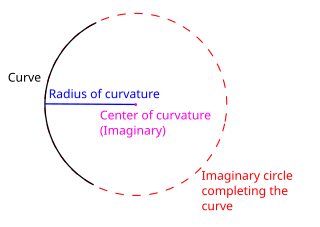In geometry, an intrinsic equation of a curve is an equation that defines the curve using a relation between the curve's intrinsic properties, that is, properties that do not depend on the location and possibly the orientation of the curve. Therefore an intrinsic equation defines the shape of the curve without specifying its position relative to an arbitrarily defined coordinate system.

Geometry is a branch of mathematics concerned with questions of shape, size, relative position of figures, and the properties of space. A mathematician who works in the field of geometry is called a geometer.
The intrinsic quantities used most often are arc length , tangential angle , curvature or radius of curvature, and, for 3-dimensional curves, torsion . Specifically:

Arc length is the distance between two points along a section of a curve.

In geometry, the tangential angle of a curve in the Cartesian plane, at a specific point, is the angle between the tangent line to the curve at the given point and the x-axis.

In mathematics, curvature is any of a number of loosely related concepts in different areas of geometry. Intuitively, curvature is the amount by which a geometric object such as a surface deviates from being a flat plane, or a curve from being straight as in the case of a line, but this is defined in different ways depending on the context. There is a key distinction between extrinsic curvature, which is defined for objects embedded in another space – in a way that relates to the radius of curvature of circles that touch the object – and intrinsic curvature, which is defined in terms of the lengths of curves within a Riemannian manifold.
- The natural equation is the curve given by its curvature and torsion.
- The Whewell equation is obtained as a relation between arc length and tangential angle.
- The Cesàro equation is obtained as a relation between arc length and curvature.

The Whewell equation of a plane curve is an equation that relates the tangential angle with arclength, where the tangential angle is the angle between the tangent to the curve and the x-axis, and the arc length is the distance along the curve from a fixed point. These quantities do not depend on the coordinate system used except for the choice of the direction of the x-axis, so this is an intrinsic equation of the curve, or, less precisely, the intrinsic equation. If a curve is obtained from another by translation then their Whewell equations will be the same.
In geometry, the Cesàro equation of a plane curve is an equation relating the curvature at a point of the curve to the arc length from the start of the curve to the given point. It may also be given as an equation relating the radius of curvature to arc length. Two congruent curves will have the same Cesàro equation. Cesàro equations are named after Ernesto Cesàro.
The equation of a circle (including a line) for example is given by the equation where is the arc length, the curvature and the radius of the circle.
These coordinates greatly simplify some physical problem. For elastic rods for example, the potential energy is given by
where is the bending modulus . Moreover, as , elasticity of rods can be given a simple variational form.
Calculus of variations is a field of mathematical analysis that uses variations, which are small changes in functions and functionals, to find maxima and minima of functionals: mappings from a set of functions to the real numbers. Functionals are often expressed as definite integrals involving functions and their derivatives. Functions that maximize or minimize functionals may be found using the Euler–Lagrange equation of the calculus of variations.




















